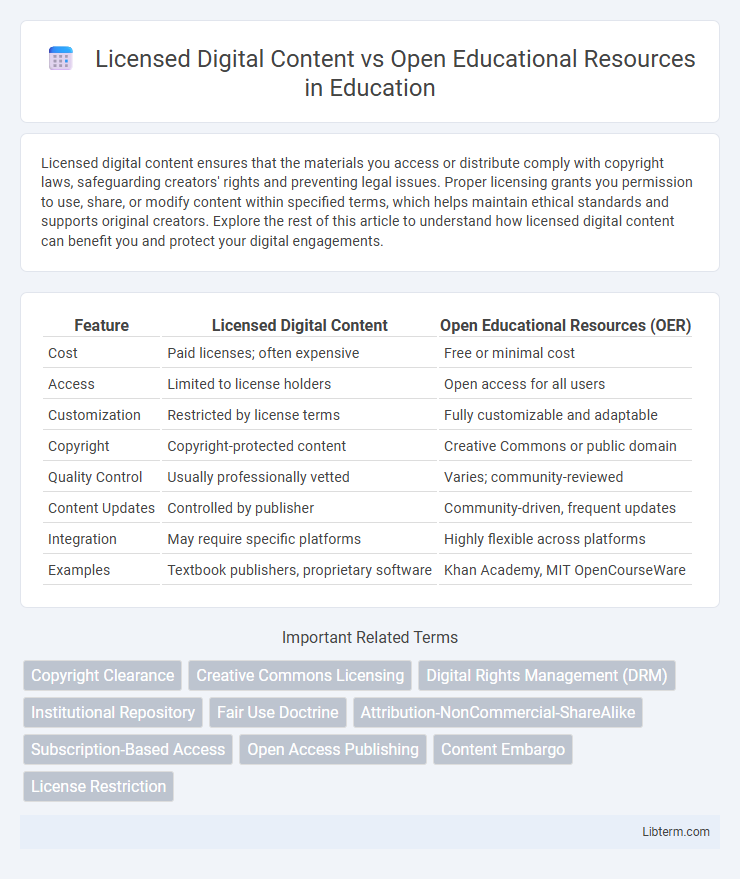Licensed digital content ensures that the materials you access or distribute comply with copyright laws, safeguarding creators' rights and preventing legal issues. Proper licensing grants you permission to use, share, or modify content within specified terms, which helps maintain ethical standards and supports original creators. Explore the rest of this article to understand how licensed digital content can benefit you and protect your digital engagements.
Table of Comparison
| Feature | Licensed Digital Content | Open Educational Resources (OER) |
|---|---|---|
| Cost | Paid licenses; often expensive | Free or minimal cost |
| Access | Limited to license holders | Open access for all users |
| Customization | Restricted by license terms | Fully customizable and adaptable |
| Copyright | Copyright-protected content | Creative Commons or public domain |
| Quality Control | Usually professionally vetted | Varies; community-reviewed |
| Content Updates | Controlled by publisher | Community-driven, frequent updates |
| Integration | May require specific platforms | Highly flexible across platforms |
| Examples | Textbook publishers, proprietary software | Khan Academy, MIT OpenCourseWare |
Understanding Licensed Digital Content
Licensed digital content refers to educational materials distributed under specific usage rights granted by copyright holders, ensuring authorized access and controlled redistribution. This type of content often includes textbooks, multimedia, and software licensed for a particular audience or institution, emphasizing compliance with intellectual property laws. Understanding licensed digital content involves recognizing the limitations and permissions associated with these licenses, distinguishing it from openly accessible resources that allow free use and adaptation.
Defining Open Educational Resources (OER)
Open Educational Resources (OER) are freely accessible, openly licensed teaching and learning materials that facilitate collaboration and adaptation. Unlike Licensed Digital Content, which often involves restrictions on access and usage, OER supports unrestricted use, redistribution, and modification to enhance educational equity. Key components of OER include comprehensive licensing frameworks like Creative Commons that empower educators and learners worldwide to share knowledge without legal barriers.
Key Differences Between Licensed and OER Content
Licensed digital content typically requires users to purchase, subscribe, or obtain permission, limiting access and distribution based on licensing agreements. Open Educational Resources (OER) are freely accessible, openly licensed materials that allow users to legally use, adapt, and share without restrictions. Key differences include cost, accessibility, permissions for modification, and redistribution rights, with OER promoting greater flexibility and collaboration in educational use.
Cost Implications: Free vs. Paid Access
Licensed digital content typically involves subscription fees or one-time purchases, leading to significant financial commitments for institutions and learners. Open Educational Resources (OER) offer free access, eliminating cost barriers and promoting equitable learning opportunities. Cost savings from OER enable reallocation of educational budgets toward other critical resources and support services.
Quality Assurance and Content Reliability
Licensed digital content undergoes rigorous quality assurance processes, including expert review and adherence to copyright standards, ensuring high reliability and up-to-date information. Open Educational Resources (OER), while freely accessible and adaptable, can vary in quality since they often lack standardized vetting mechanisms, potentially affecting content accuracy. Institutions seeking consistent and credible educational materials prioritize licensed content for dependable learning outcomes and reduced risks of misinformation.
Copyright Restrictions and User Rights
Licensed digital content is typically protected by strict copyright restrictions that limit redistribution, modification, and reuse without explicit permission from rights holders, often requiring users to comply with specific licensing agreements. Open Educational Resources (OER) are released under licenses such as Creative Commons, which grant users broad rights to freely access, adapt, and share the materials while ensuring attribution and adherence to license terms. Understanding the legal frameworks governing both types is essential for educators and learners to maximize resource utilization while respecting intellectual property laws.
Flexibility in Adaptation and Customization
Licensed digital content often comes with strict usage rights limiting flexibility in adaptation and customization, restricting educators' ability to modify materials to fit specific teaching goals. Open Educational Resources (OER) provide greater flexibility by offering openly licensed materials that educators can freely adapt, remix, and distribute to tailor content to diverse learner needs. This adaptability makes OER an efficient choice for personalized education and curriculum innovation.
Impact on Teaching and Learning Experiences
Licensed digital content offers curated, proprietary materials often accompanied by specialized features such as interactive assessments and multimedia elements, enhancing engagement and aligned with specific curriculum standards. Open Educational Resources (OER) provide freely accessible, adaptable content fostering collaborative learning environments and enabling educators to customize materials to diverse student needs, promoting inclusivity and innovation. The integration of both licensed content and OER allows educators to balance quality assurance with flexibility, thereby enriching the overall teaching and learning experiences.
Accessibility and Global Reach
Licensed digital content often restricts access due to copyright limitations and subscription costs, limiting global reach to institutions or individuals who can afford or obtain licenses. Open Educational Resources (OER) eliminate these barriers by providing freely accessible, adaptable materials that support inclusive learning across diverse geographical and socio-economic contexts. This openness enhances educational equity and enables widespread dissemination, particularly benefiting underserved or remote communities worldwide.
Choosing the Right Resource for Your Needs
Choosing between licensed digital content and open educational resources (OER) depends on factors such as budget, accessibility, and customization needs. Licensed digital content often offers high-quality, curated materials with comprehensive support, but may involve costly subscriptions and limited adaptability. Open educational resources provide free, flexible content that can be modified to suit specific curricula, making them ideal for educators seeking cost-effective and customizable teaching materials.
Licensed Digital Content Infographic

 libterm.com
libterm.com